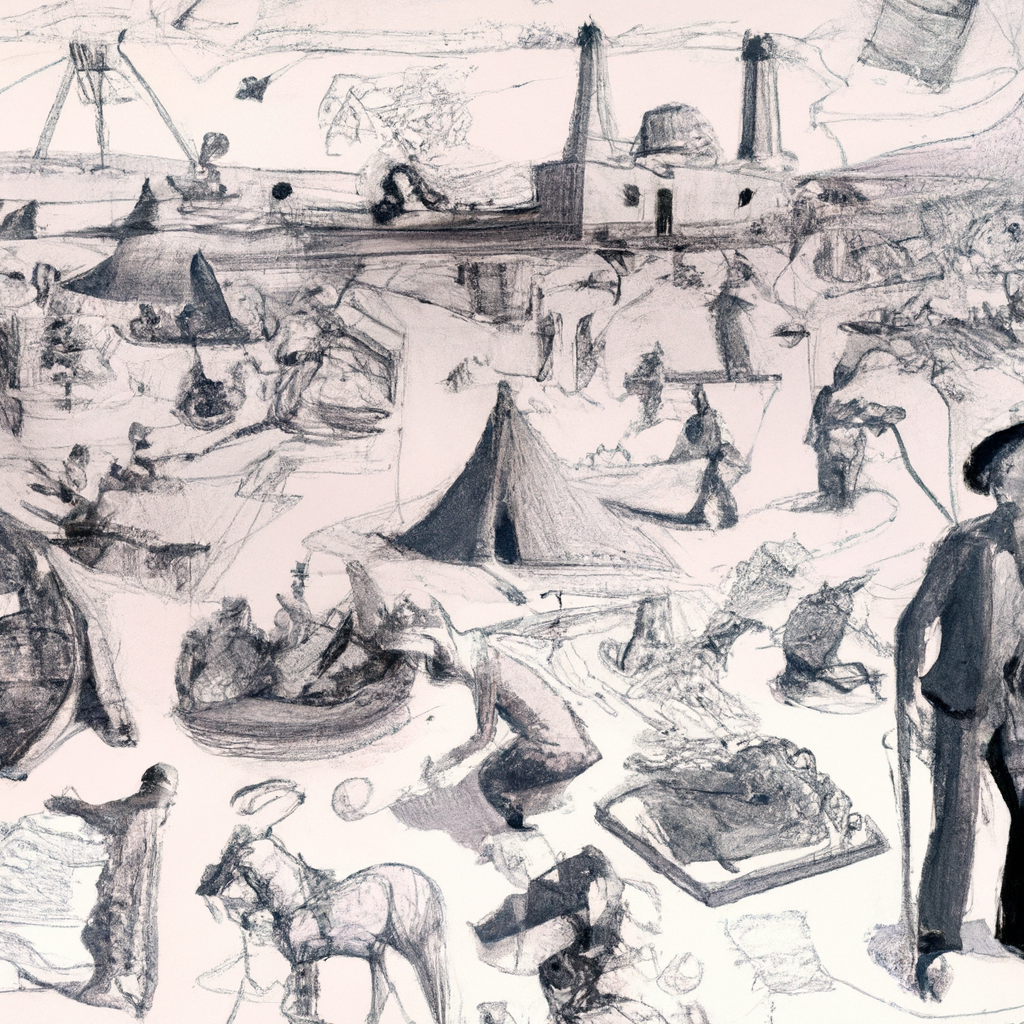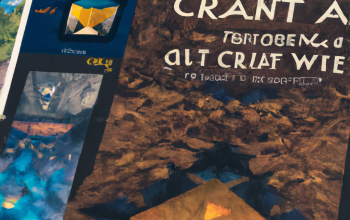In the vast realm of creativity and imagination, there exists a melting pot of art forms waiting to be explored. Among the countless mediums that captivate our senses and inspire our minds, games stand out as a unique platform where boundaries are meant to be crossed, and art forms are destined to converge. Welcome to a journey delving into the expressive fusion of different artistic realms within the captivating realm of gaming. In this article, we invite you to join us on an exploration that unveils the extraordinary ways in which games intertwine various creative domains, creating a rich tapestry of emotions and experiences that transcend conventional artistic boundaries. Prepare to be immersed in a world where visual arts shake hands with music, storytelling intertwines with game design, and theater merges with technology, all to push the boundaries of what we know as games. Let us embark on this creative odyssey, where the lines between art forms blur, and where inspiration knows no limits.

Exploring the Artistic Interplay: The Fusion of Visual and Auditory Elements in Games
In the realm of gaming, the powerful combination of visual and auditory elements takes players on a sensory journey like no other. Games have evolved from simple pixelated screens to immersive virtual worlds, and with this progress, the integration of stunning visuals and captivating soundscapes has become an integral part of the gaming experience. This interplay between the visual and auditory elements is a true art form, elevating the levels of immersion and creating unforgettable moments for players.
Visuals in games have experienced a revolution, pushing the boundaries of graphic design and storytelling. From intricately detailed characters to breathtaking landscapes, every aspect is meticulously crafted to captivate and transport players into these virtual realms. The fusion of visual elements, such as realistic textures, vibrant colors, and seamless animations, induces a sense of awe and wonder, enhancing gameplay and narrative-driven experiences. Paired with the auditory components, these visuals are elevated to new heights, as the marriage of sight and sound immerses players on a deeper level.
- Soundtracks and scores: Games utilize orchestral compositions, electronic beats, or dynamic soundscapes to set the mood and evoke emotions during gameplay.
- Sound effects: From the clashing of swords to the swooshing of arrows, sound effects enhance the realism and impact of actions within the game world.
- Voice acting: Characters come to life through voice acting, delivering compelling performances that immerse players in the narrative and enhance storytelling.
The combination of these elements in games creates an immersive experience that fully engages the senses and transcends traditional entertainment. As technology continues to advance, the artistic interplay between visuals and auditory elements is poised to deliver even more captivating experiences, pushing the boundaries of what is possible in the gaming industry.
Analyzing Narrative Techniques: Melding Storytelling and Interactive Gameplay Experiences
When it comes to crafting exceptional and immersive video game experiences, narrative techniques play a pivotal role in captivating players and keeping them engaged. The art of melding storytelling and interactive gameplay has evolved significantly over the years, giving rise to incredibly rich and dynamic gaming worlds that resonate with players on a deeper level.
One of the key narrative techniques that game developers employ is character development. Through well-crafted characters, games can convey intricate emotions, motivations, and personal journeys that players can relate to. By fleshing out these characters, whether through detailed backstories, unique traits, or memorable dialogue, games can create a more compelling and memorable experience for players.
- By immersing players in a captivating narrative, games can transport them to magical realms, dystopian futures, or even historical epochs.
- Multiple perspectives: Through interactive gameplay, developers can allow players to experience events from various perspectives, enriching the narrative and providing a broader understanding of the game’s world.
- Branching storylines: Implementing branching narratives provides players with choices that shape the direction and outcome of the game, offering a sense of agency and personal investment.
By seamlessly integrating storytelling elements into the interactive gameplay experience, developers can create a game that not only entertains but also sparks emotions, provokes thought, and leaves a lasting impact. The evolution of narrative techniques in gaming has undoubtedly revolutionized the way we perceive and engage with digital storytelling, and the possibilities for captivating narrative-driven gameplay experiences are endless.
Unleashing Creative Potential: Encouraging Collaboration Between Artists and Game Designers
In the realm of gaming, where immersive storytelling meets mesmerizing visuals, the collaboration between artists and game designers holds the key to unlocking boundless creative potential. By bridging the gap between the realms of art and technology, game creators are able to breathe life into virtual worlds that captivate players like never before.
- Breaking Conventional Boundaries: Encouraging collaboration between artists and game designers allows for the fusion of diverse perspectives, resulting in unique and unconventional gaming experiences. Artists inject their imagination and visual expertise, pushing the boundaries of aesthetics and creating visually stunning landscapes, characters, and animations.
- Seamless Integration: Integrating art and design seamlessly is crucial for an immersive gaming experience. By fostering collaboration, game designers work hand in hand with artists to ensure that the visuals harmonize with the game mechanics and narrative, enhancing the overall gameplay. This synergy brings depth to the virtual universe, enveloping players in an enchanting world that feels both tangible and extraordinary.
Collaborating between artists and game designers not only paves the way for groundbreaking innovation but also cultivates a deep sense of creativity that fuels the gaming industry. It is through this collaborative effort that masterpieces are born, captivating millions and leaving an indelible mark on the world of gaming.
Inspiring Multidisciplinary Approaches: Integrating Literature, Music, and Visual Arts in Game Development
When it comes to game development, the possibilities are endless. It is not just about coding and programming; it is about creating a whole new world that players can immerse themselves in. One of the most innovative and inspiring approaches in game development is the integration of literature, music, and visual arts. By combining these three disciplines, game developers are able to create breathtaking and captivating gaming experiences that go beyond traditional gameplay.
The integration of literature in game development brings storytelling to a whole new level. With carefully crafted narratives and well-developed characters, players are transported into a rich and immersive world. They become active participants in the story, making decisions that shape the outcome. The use of music further enhances the gaming experience, evoking emotions and setting the tone for different situations. Whether it’s a thrilling chase scene or a melancholic moment, the right musical composition can truly elevate the player’s engagement. Additionally, the inclusion of visual arts, such as stunning graphics, concept art, and animation, adds a visual feast for the eyes. From breathtaking landscapes to intricate character designs, every detail is thoughtfully curated to create a visually stunning and captivating gaming experience.
Final Thoughts
In a world where boundaries separate, where lines are drawn to define and confine, one realm stands defiant. Games, the ever-evolving platform of creativity, shatters the barriers that confine traditional art forms. It dares to explore the uncharted territories, daring the impossible by fusing diverse expressions into a harmonious symphony of visual, auditory, and interactive delights.
In this journey, we have delved into the boundless depths of game design, uncovering the astonishing fusion of different art forms. From the graceful brushstrokes of a master painter to the pulsating beats composed by a virtuoso, games have become the canvas upon which these art forms converge and intertwine, creating an unprecedented tapestry of emotions and experiences.
With each new creation, game developers push the boundaries of what is possible, stretching the realms of imagination and inviting us to lose ourselves in the immersive worlds they fashion. The virtual landscapes become a playground for visionaries, where the poetic verses of literature coexist with the captivating stillness of photography, where the rousing melodies of a symphony resonate with the vibrant cadence of contemporary dance.
It is within these worlds that we find ourselves, where we can be both spectator and participant. The lines blur as we inhabit alternate universes, where storytelling becomes interactive and the audience becomes an integral part of the unfolding narrative. The very act of playing becomes a form of art, where the nuance of a gesture can shape an outcome, where our choices give birth to new possibilities.
As we conclude this exploration into the expression and fusion of different art forms in games, we are left with a profound realization – boundaries exist only to be challenged and overcome. Through games, we are reminded that art has no limits, no confinements. It breathes life into the mundane, transforms the ordinary into the extraordinary, and propels us into a world where creativity knows no bounds.
So let us celebrate the artists, the designers, and the visionaries who continue to push the boundaries of artistic expression within the realm of games. Let us acknowledge the profound impact they have had on the art world as a whole, blurring the lines between mediums and creating new possibilities for generations to come.
In this ever-evolving tapestry, where imagination runs wild and inspiration is boundless, one thing remains clear – games have become a platform for the convergence of art, defying conventions and forging new paths. Let us embark on this endless journey of exploration, where the expression and fusion of different art forms in games await our awe and wonder, guiding us towards the boundless possibilities that lie just beyond the horizon.
Crossing Boundaries: Exploring the Expression and Fusion of Different Art Forms in Games
From its humble beginnings in the mid-20th century, the gaming industry has grown exponentially to become one of the most influential and lucrative forms of pop culture entertainment. Today, it is no longer just a distraction or a pastime for kids, but instead something people of all ages and backgrounds are investing their time and energy in. As such, it comes as no surprise that this has also driven an exploration of the boundaries of what constitutes a game, and how different art forms can be brought together to create something entirely new.
At its core, no game would be complete without the visuals, sound, story, and design that draw players in and keep them engaged. This exploration of art forms has been especially relevant in recent years, as the industry has seen a deluge of virtual reality and augmented reality games appear on the scene. Settling somewhere between a video game and a movie, these have taken the expression of art to a whole new level by creating virtual worlds for players to explore and interact with.
Similarly, the growing popularity of serious games has also provided an opportunity for developers to explore how different art forms can be brought together to create a meaningful and engaging experience. These games are designed specifically to educate or to raise awareness of a particular issue. They often blend together elements of traditional gaming such as puzzles, story, and levels with other art forms such as music, illustration, and animation.
Finally, there has been an increasing interest in what is known as “fusion” games. These blend different game genres together to create something truly unique. This could be a combination of an RPG with an FPS, or a board game with a real-time strategy game. By introducing elements of different worlds and genres, developers can create something that is both visually and conceptually enthralling for players.
Ultimately, the exploration of art forms in games is a testament to the power of creativity and the opportunities that the medium provides for experimentation. This fusion of different art forms not only helps to create something unique and interesting, but it can also bring to life powerful messages and stories that resonate with players. As the industry continues to grow, it can only be hoped that this trend of pushing boundaries and striving for creativity and originality will remain as a driving force for many years to come.



